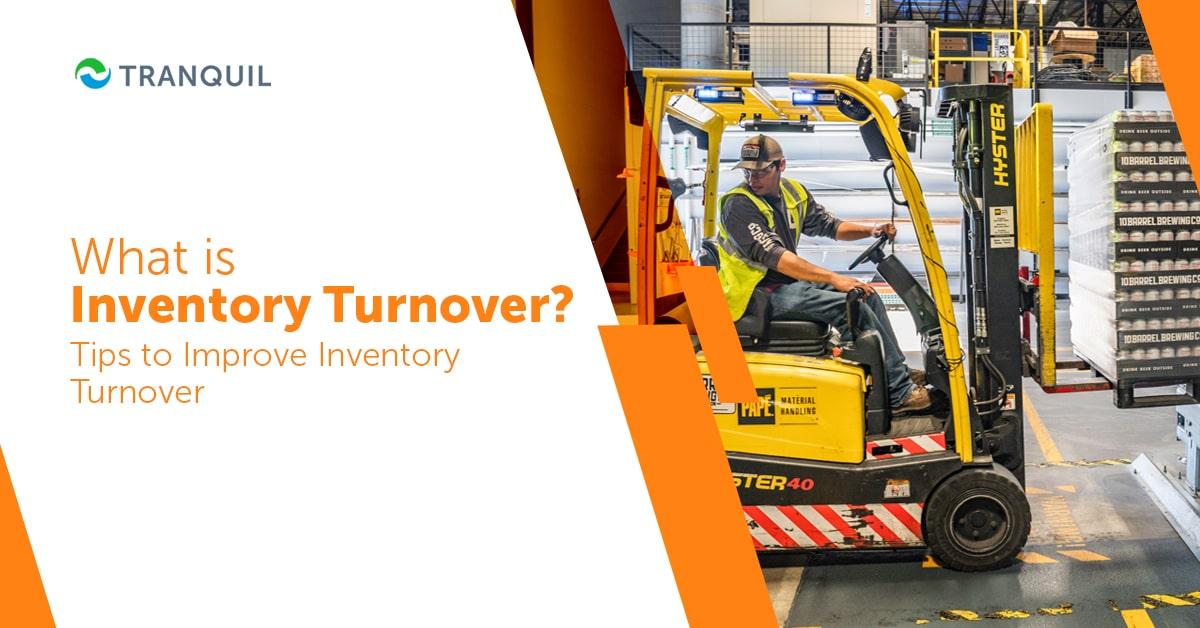
What is Inventory Turnover? Tips to Improve Inventory Turnover
Inventory is crucial for any business dealing in products – manufacture or sale.
Managing inventory is a very complex function as there are multiple factors to be considered.
One of them is inventory turnover.
What is Inventory Turnover?
Inventory turnover refers to how much inventory or stock of products your business has sold in a specific period.
Knowing the figure offers several insights into which of your products are selling well, along with how the overall costs are managed by the company.
So, what does this mean for your organization essentially?
A low inventory turnover is not good news; it means delayed replenishment of inventory or excess stock of inventory that doesn’t sell quickly.
On the other hand, a high inventory turnover indicates good cash flow because there is high demand for your products.
ALSO READ: Common Inventory Management Mistakes to Avoid
What is Inventory Turnover Ratio?

The inventory turnover ratio is an indication of the efficiency of your inventory management, and is arrived at by comparing the average inventory held over a specific time period, with the cost of goods sold.
It shows the number of times the average inventory of a company is turned or sold during a specific time period.
This effectively translates into the number of times a company could sell its average inventory in monetary terms in a year.
If a business has an average inventory of SAR 20,000, and SAR 100,00 in annual sales, it means that it turned its inventory 5 times in a year.
ALSO READ: Inventory Cycle Counting and What are its Benefits?
How Is Inventory Turnover Ratio Calculated?
We can calculate the inventory turnover ratio by dividing the total COGS for a specific time period by the average inventory for the same period.
The inventory turnover formula can be expressed as :
Inventory turnover ratio = COGS / Average Inventory
What is Considered a Favorable Inventory Turnover Rate?
Anything between 4 and 6 is considered a good inventor turnover ratio as it indicates that you have a good balance between restocking items and sales inventory.
Anything above it indicates strong sales performance and below it could be an indicator of poor sales.
For example, if you use the inventory turnover calculator and get the answer 1 it means that you had say 200 items in stock and you sold 200 – all of them.
However, if you sold 800 products and still have 200 items in inventory, it means that your inventory turned four times, or your ITR is 4.
The inventory turnover ratio is typically calculated at the end of the financial year; however, it can differ depending on unique business requirements.
ALSO READ: Inventory Management Trends to Know
How to Improve Inventory Turnover?

Now that you know what is inventory turnover and how to calculate it, you should also know how you can bring more efficiency in managing your inventory, reduce warehousing expenses, and increase sales.
The benefits of improving your inventory turnover are many:
- When inventory sells quickly your carrying costs are low
- Your cash keeps getting freed, enabling you to replenish stock or invest them elsewhere
- Enables businesses to respond quickly to the marketplace and react to demand changes
- Minimize the possibility of excess and obsolete stock, and selling at a loss.
Track your inventory turnover ratio closely so as to see how well you’re doing this.
Calculating inventory turnover helps to measure your efficiency at this.
ALSO READ: What Is Gross Margin Return on Investment (GMROI)?
A low turnover ratio could have several causes:
- Not having the resources to place more orders
- Minimum order quantities to be maintained with suppliers
- Lack of warehousing facilities
Holding less stock increases risk of getting stocked out, and having to turn customers away.
So here are some guidelines on improving your inventory turnover.
ALSO READ: Detailed Guide on Budget Variance Analysis
Tips to Improve Inventory Turnover
1. Knowing the Inventory Items’ Position in their Product Life Cycle
Demand for products varies as they progress through their product life cycle.
Products in the growth stage experience rising demand, and it falls as they mature, holding steady at a particular level.
The demand tends to become erratic as the product ages, and then declines and becomes very low.
This means that your inventory portfolio at any given time, has hundreds of SKUs exhibiting varying demand patterns.
You need to focus on products entering the stage of decline and monitor their demand closely to build strategies to decrease stocks before they become obsolete.
Reducing reorder quantities and safety stock levels, using marketing campaigns or pricing strategies to boost demand and sell the stock faster before customers become disinterested, are all tactics you could try out.
ALSO READ: What is Inventory Aging and Why is it Important?
2. Better Demand Forecasting Accuracy

If you want to improve your stock turnover, it is essential that you order those items which are likely to have good demand in the market – this brings us to accuracy in demand forecasts.
Using moving averages and specific stock days for demand calculation will not give you the right forecast.
Without accurate forecasting, you may end up overstocking, which leads to dead stock, or understocking, which leads to loss of sales, customers, and business.
To be able to factor in the fluctuations of demand and supply and get precise demand predictions, you need an effective inventory management solution.
This will give you demand forecasts based on scientific and statistical methods.
ALSO READ: Make to Order vs Make to Stock
Basically, you need to factor in the demand type of a specific inventory item based on its position in the product life cycle, and accordingly fine-tune the forecast algorithms.
Products that have seasonal demand patterns should be identified to adjust the forecast further.
The third thing that needs to be done is to factor in the unpredictability of demand in the market to fine-tune the forecast further.
For example, for markets where demand is generally slow, define longer periods of forecasting, and if the demand is unpredictable, use shorter forecasting periods.
Lastly, you need to factor in promotional activities like campaigns, which may boost sales as well as competition which may cause a fall in sales.
ALSO READ: What is Assemble to Order Process?
3. Inventory Classification for Prioritizing Stock
Apart from variations in demand type, your inventory items will also differ in terms of their demand fluctuation, cost of selling, profit margin, and frequency of picking.
This is why it may not be a smart idea to have a generalized policy for inventory stocking, managing all the items in your portfolio in the same manner.
You need to instead look at prioritizing inventory items based on the factors mentioned above.
When you categorize inventory items into different groups, you will be able to handle products with similar features in the same way.
In this manner, you can optimize your inventory levels, and have a better inventory turnover ratio.
ALSO READ: Physical Stock Verification and Its Advantages
ABC analysis or other basic inventory classification form allow you to categorize inventory items on a single dimension – the value they contribute to the business.
But you need a more detailed and sophisticated categorization mechanism, looking at multiple variables that impact turnover rates; for example, demand, cost, or picking frequency.
This will allow you to have inventory stocking strategies that are multi-dimensional in nature, and decide how much to buy and store of what items.
Optimizing inventory levels will help you boost your inventory turnover quite rapidly, without running the risk of getting stocked out.
ALSO READ: Benefits of Stock Status
4. Reorder Smarter

Placing huge orders to get discounts from suppliers looks attractive at first; however, it will impact your inventory turnover badly.
After all, you need to spend to carry inventory, and so your working capital gets tied up in inventory to a great extent.
Again, if the products you purchase don’t have high demand, they could end up as dead stock, costing your business dearly.
The ideal situation is ordering small quantities regularly so that you have minimal investment, and your stock keeps turning.
You need to remember however, that restrictions on ordering imposed by suppliers or inefficient processes may not render this possible.
Here it becomes critical that you replenish products very thoughtfully and intelligently.
The right ERP solution can help you do this easily, with features like order fill up (in case of minimum order quantity) where it recommends the most suitable products to add to the purchase order.
It takes into consideration, sales trends, seasonal behavior and more, so that you fill up the minimum quantity with the ideal products.
ALSO READ: What is Inventory Reorder Point(ROP)?
5. Finish Excess Inventory Stock Redistribution
Businesses with multi-location warehouses are likely to notice that in each location, the inventory turnover is different.
The same SKU may be in excess in one location, while it is stocked out elsewhere. Hence, it is prudent to look at pan-organizational data, and optimize inventory items across locations, by redistributing stock before you replenish them.
This way you will not have to resort to placing expensive emergency orders with suppliers, and also maintain a lean inventory.
6. Automate and Improve Insights

As mentioned earlier, the need of the hour is a robust inventory management system like the one provided by Tranquil ERP.
It lets you monitor stock levels and offers an accurate base for the inventory turnover calculation to improve it.
Tranquil ERP can calculate and track inventory turnover ratios right down to the level of SKUs so that you can easily identify the products which do not deliver the requisite return on investment.
It can also optimize your inventory levels, forecast demand accurately, help you plan your inventory purchasing, stocking, classification and replenishment activities more efficiently.
ALSO READ: What is Stock Adjustment and Stock Transfer?
To Conclude
Inventory is a vital asset for any business, and managing it properly in a way that it increases the profitability of the business is a complex and critical function.
Tranquil ERP can simplify this function for you and allow you to focus on value-adding activities.
Do schedule a demo at your convenience and we will be happy to help you understand how Tranquil can benefit your business. Our executives will be at hand to answer any query you may have.



